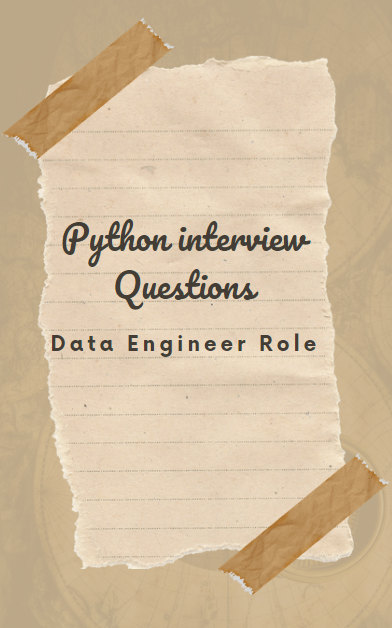Skip to content
Here are 50 Python interview questions for a Data Engineer:
- What is the difference between a tuple and a list in Python?
- What is a Python dictionary, and how is it different from a list?
- What are decorators in Python, and how are they used?
- What is the difference between a static method and a class method in Python?
- What is the use of lambda functions in Python?
- What is the purpose of the “yield” keyword in Python?
- How do you handle exceptions in Python?
- How do you check the type of an object in Python?
- What are the differences between “is” and “==” in Python?
- How do you use regular expressions in Python?
- What is the difference between shallow and deep copy in Python?
- What is the purpose of the “with” statement in Python?
- What is the difference between “append” and “extend” in Python?
- What is the purpose of the “zip” function in Python?
- What is the difference between “map” and “filter” in Python?
- What is the purpose of the “enumerate” function in Python?
- What is the difference between a generator function and a regular function in Python?
- What is the purpose of the “itertools” module in Python?
- How do you perform multi-threading in Python?
- What is the difference between multi-threading and multi-processing in Python?
- How do you read and write files in Python?
- What is the purpose of the “pickle” module in Python?
- What is the difference between NumPy and Pandas in Python?
- What is the use of the “groupby” function in Pandas?
- How do you merge data frames in Pandas?
- What is the difference between a join and a merge in Pandas?
- What is the purpose of the “apply” function in Pandas?
- What is the use of the “pivot_table” function in Pandas?
- How do you handle missing data in Pandas?
- What is the difference between a Series and a DataFrame in Pandas?
- What is the purpose of the “iloc” and “loc” functions in Pandas?
- How do you create visualizations in Python?
- What is the purpose of the “matplotlib” library in Python?
- What is the difference between a scatter plot and a line plot in Python?
- What is the use of the “seaborn” library in Python?
- What is the purpose of the “plotly” library in Python?
- What is the use of the “Bokeh” library in Python?
- What is the difference between a bar chart and a histogram in Python?
- How do you create dashboards in Python?
- What is the purpose of the “Dash” library in Python?
- What is the use of the “Streamlit” library in Python?
- What is the purpose of the “PySpark” library in Python?
- What is the difference between RDD and DataFrame in PySpark?
- What is the use of the “SQLContext” class in PySpark?
- What is the difference between the “map” and “flatMap” functions in PySpark?
- How do you read and write data in PySpark?
- What is the purpose of the “join” function in PySpark?
- How do you handle missing data in PySpark?
- What is the difference between “groupBy” and “reduceByKey” in PySpark?
- What is the use of the “SparkSession”
